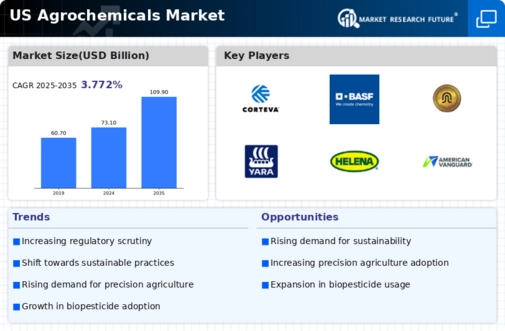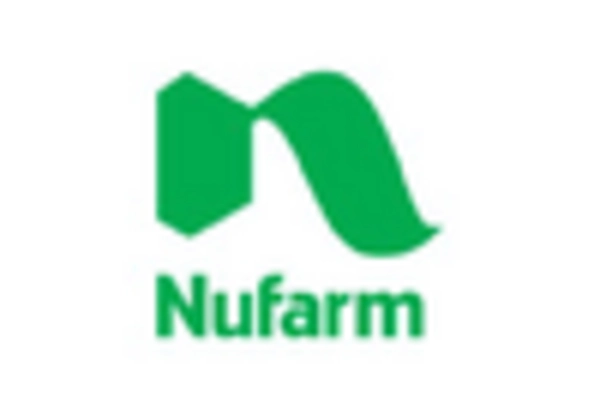Rising Demand for Food Security
The increasing The agrochemicals market in the US. As agricultural productivity needs to rise to meet these demands, farmers are turning to agrochemicals to enhance crop yields. The US Department of Agriculture indicates that crop production must increase by approximately 70% by 2050 to ensure food security. This scenario compels farmers to adopt agrochemicals that improve efficiency and productivity, thereby propelling the market forward. Furthermore, the agrochemicals market is expected to witness a compound annual growth rate (CAGR) of around 4% over the next few years, reflecting the urgency of addressing food supply challenges.
Adoption of Precision Agriculture
The integration of precision agriculture techniques is significantly influencing the agrochemicals market. Farmers are increasingly utilizing technology such as GPS and IoT devices to optimize their use of agrochemicals, ensuring that inputs are applied more efficiently. This trend not only reduces waste but also enhances crop yields. According to recent data, precision agriculture can lead to a reduction in agrochemical usage by up to 20%, which is likely to attract more farmers to these practices. As a result, the agrochemicals market is expected to expand as farmers seek products that align with precision agriculture methodologies, thereby enhancing overall productivity.
Growing Awareness of Crop Protection
The increasing awareness among farmers regarding the importance of crop protection is a significant driver for the agrochemicals market. As pests and diseases pose a constant threat to crop yields, farmers are becoming more proactive in utilizing agrochemicals to safeguard their harvests. Educational initiatives and outreach programs by agricultural organizations are enhancing this awareness, leading to a rise in the adoption of crop protection products. Reports indicate that the crop protection segment of the agrochemicals market is projected to grow by approximately 5% annually, reflecting the heightened focus on maintaining crop health and productivity.
Regulatory Support for Agrochemical Use
Regulatory frameworks in the US are evolving to support the safe and effective use of agrochemicals, which is positively impacting the agrochemicals market. The Environmental Protection Agency (EPA) has established guidelines that facilitate the approval of new agrochemical products while ensuring environmental safety. This regulatory support encourages innovation and the introduction of new products that meet safety standards. As a result, the agrochemicals market is likely to benefit from a more favorable regulatory environment, which could lead to increased product availability and enhanced market growth. The alignment of regulatory policies with agricultural needs is expected to foster a more robust agrochemicals market.
Increased Investment in Research and Development
Investment in research and development (R&D) within the agrochemicals market is crucial for innovation and product development. Companies are focusing on creating new formulations that are more effective and environmentally friendly. The US agrochemicals market has seen a surge in R&D spending, with estimates suggesting that it could reach $5 billion annually by 2027. This investment is likely to lead to the introduction of advanced agrochemical products that cater to the evolving needs of farmers, thus driving market growth. Moreover, the emphasis on developing biopesticides and biofertilizers is expected to reshape the market landscape, aligning with sustainable agricultural practices.

















Leave a Comment